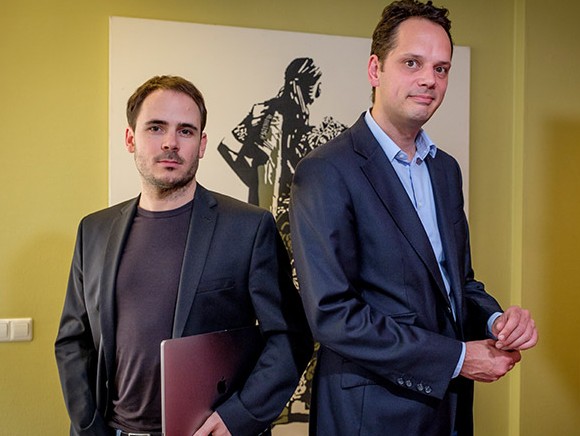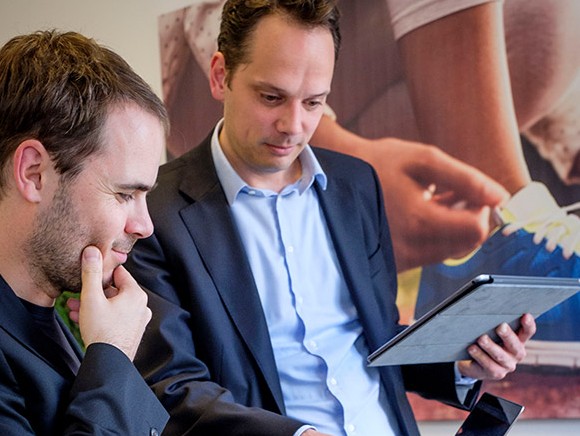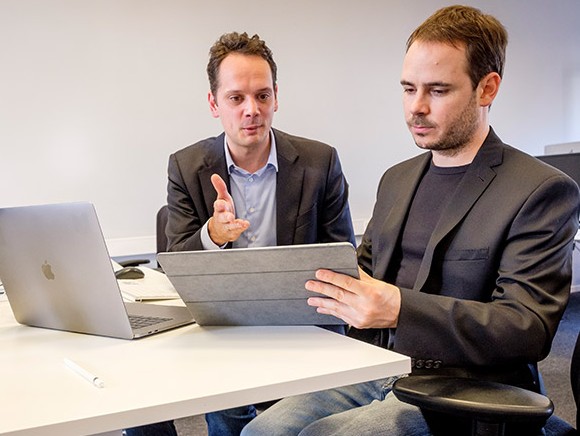
The term ‘blockchain’ is creating a buzz in the food industry. Some people are enthusiastically claiming that it has the potential to radically change the sector, leading to substantial investment in the technology by major players. But for now, the activity remains largely experimental.
The developments cannot move quickly enough as far as Joost Schuttelaar and Tijmen de Vries from Schuttelaar & Partners are concerned. “Our advice is: just give it a go.”
Blockchain is related to collaboration within an industry; it helps companies within a particular sector to build trust and control, and to create transparency. It is a system for recording transactions and other information in a database. It works as follows: each transaction is stored as a block. The block is given a code which enables you to see that the transactions in that block have not been changed. In the case of subsequent transactions, a new block is opened and given a code that refers to the previous block. That creates a chain of blocks, hence the name ‘blockchain’. The blockchain is managed by its users, meaning there are no supervisory authorities involved. All users have a copy of the database and they all simultaneously see which new data has been added. Tampering with the data will invalidate the code and the chain is broken. This enables you to create a reliable database and to take corrective action quickly. The data in a blockchain is public, but it can also be encrypted for storage and only made visible for authorised parties. Bitcoin – a digital currency – was the first application supported by blockchain technology. The technology ensures that a bitcoin can only be spent once, for example.
‘The success of blockchain in the food sector depends on the willingness to share information’
Joost Schuttelaar and Tijmen de Vries, who both work for the communications consultancy firm Schuttelaar & Partners, are working on a pioneering project with Kipster and other parties to set up a blockchain to provide an overview of the egg supply chain. They are monitoring the blockchain-related developments in the food industry with great interest.
Blockchain is very hard to explain without a concrete example. So let’s take an apple, for instance. Which data is relevant for storage in a blockchain?
Schuttelaar: “The blockchain contains all transactions and other information, from farm to fork. After being harvested, a crate of apples is labelled with information about pruning, where the fruit was grown, any crop protection agents and fertilisers used, the name of the orchard, the picking date and method, and maybe even when the sorter was last maintained. Besides that details are recorded – some automatically and some by hand – about transport, storage, the sales location and any characteristics. The same holds true for apples that end up being turned into apple sauce.” De Vries: “It’s more complex, of course, in the case of a processed product such as a ready-to-heat pizza with lots of different ingredients and processes, some of which may even be done abroad. It’s more challenging to set up a blockchain for a product like that.” Schuttelaar smiles: “But it’s more fun too!”

Joost Schuttelaar & Tijmen de Vries
Schuttelaar & Partners is a communications consultancy active in the areas of sustainability and health. The company was founded over 20 years ago by Marcel Schuttelaar. His son, Joost, is a managing partner and runs the online division. He develops digital applications and advises companies about effective online communications. Tijmen de Vries works for the firm as a sustainable supply chain consultant. He has considerable experience in agro commodities with complex international supply chains, including coffee and tea.
Schuttelaar: “There are a couple of good reasons. A blockchain makes it difficult to commit fraud because it’s impossible to tamper with stored data. By sharing information, the sector can regulate itself and root out the ‘bad guys’. If you notice any unexpected statistical patterns in the blockchain, you can decide to investigate. In the case of the fipronil affair, you would have been able to spot that a new company selling a new decontamination product had secured a large portion of the market within a short space of time. Blockchain also improves food safety. For instance, if there is an incident you can quickly analyse where things have gone wrong. It recently took weeks to trace which egg products might contain fipronil, but with a blockchain you can find out in just a couple of clicks. The technology would have enabled us to prevent some of the food scandals we’ve seen over recent years.” De Vries continues: “Consumers are clearly calling for transparency and supply chain sustainability. Much is already being done in those areas, but blockchain also gives consumers more precise insight into where their food has come from and which route it has taken. Furthermore, it’s important to show the impact of what you do, such as in terms of sustainability and fair trade. You could include a blockchain containing information about the working conditions for the farmers who grow your coffee beans, for example. The technology is ideal for direct trade.”
“Our advice is: just give it a go”
Schuttelaar adds: “The data can become part of your product story towards consumers. However, this depends on the blockchain being compatible with simple applications so that the information is easy for consumers to unlock and read.” According to Schuttelaar there is yet another important reason for the food sector to set up a blockchain: “Many supply chain partners like to benchmark themselves against their peers. They want to learn from one another. Blockchain gives you feedback on how your product is used by customers and how you might be able to improve that.”
Schuttelaar: “You’re right, that’s the big question. Many companies regard data-sharing as a risk. The data contains lots of value; it’s their business. But if you don’t make your data transparent then the blockchain will be soulless. On the other hand, the great thing about the system is that we can’t even see all the possibilities yet. New applications will emerge that we’re not even able to predict right now, just as happened with the internet. Those scientists couldn’t have imagined that their creation would be used for Snapchat some 50 years later.”
De Vries: “One precondition is to manage the supply chain, and hence human actions. Because it covers the entire chain, it’s important to reach agreement with all partners – from raw materials to the finished product – about the data that will be stored in the blockchain. Which information is relevant for the chain? What does the consumer want to know?” Schuttelaar: “It’s also useful to have consensus on the standards you will use, but not essential. You can share information independently of one another too.”

De Vries: “That’s impossible to predict. Companies like Nestlé and Unilever are already experimenting with it, but it’s not only for the industry giants. In this phase, the system is extremely suitable for short supply chains and SMEs, because their blockchains are less complex. For SMEs the investments are relatively low because they can experiment more freely without legacy systems.” Schuttelaar: “Dozens of blockchains will be set up in the food industry over the coming years. Eventually one system will emerge that will be adopted by the whole sector. The chance of success depends on whether companies are prepared to be open enough. You can encrypt data, but the openness of blockchain is what makes it so revolutionary.” De Vries: “Our advice is to seize the momentum and just give it a try. Talk to your supply chain partners. And if there’s scepticism, start with the ‘no regrets’ first. At the very least, blockchain is stimulating dialogue between supply chain partners and that’s always a good thing.”
Source: © Roel Dijkstra Fotografie